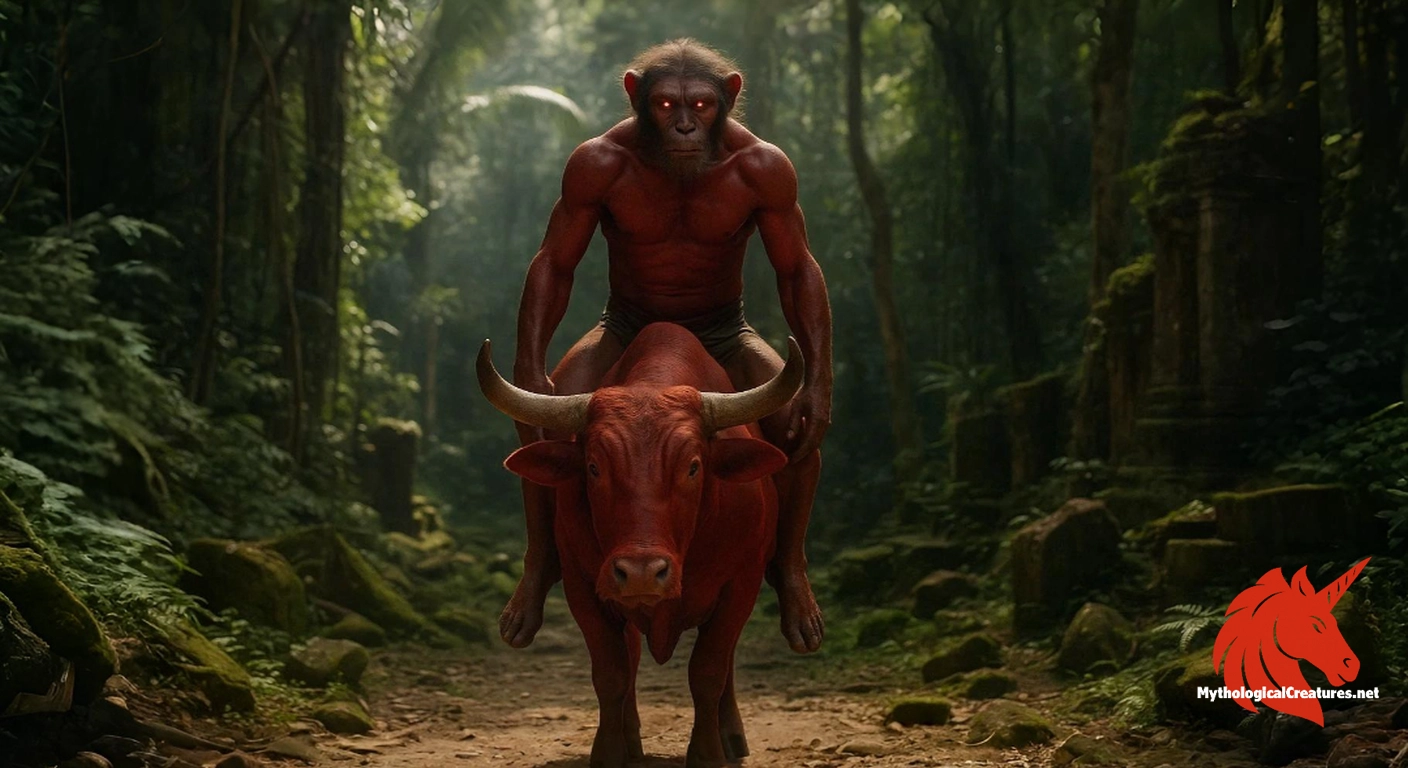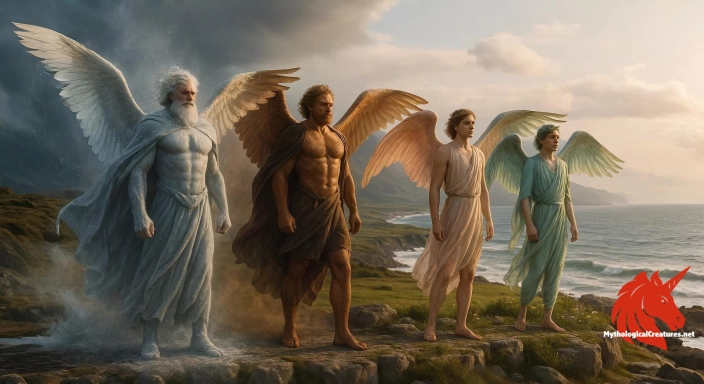Reeri Yakseya: Reeri Yakseya, also known as Riri Yaka, is a formidable demon from Sinhalese folklore with a human body and a monkey head.

Reeri Yakseya
Reeri Yakseya - Represents a terrifying, uncontrollable demonic force in Sinhalese mythology, second only to Mahasona, whose multiple incarnations underscore his deep-rooted impact on folklore.
Origins & First Encounters
Reeri Yakseya stands as one of the most formidable and feared demons in the rich tapestry of Sinhalese folklore. Esteemed in local legends as second only to the notorious Mahasona, his origins are woven from strands of ancient myth and societal anxiety. This demon, with a human body and a monkey’s head, has captured the imagination of local cultures for centuries. Legend holds that his fiery red skin and ruthless demeanour set him apart as both a cautionary figure and a symbol of unbridled chaos. His first attestation can be traced back to early folk narratives and whispered tales passed down orally among villagers. The intricate lore surrounding his character reflects deep-rooted cultural beliefs concerning health, mortality, and the supernatural realm. Reeri Yakseya’s presence often invoked a blend of fear and respect, as his very existence mirrored the unpredictable forces of nature and fate. His vivid portrayal combines human vulnerability with animalistic savagery, making him an enduring archetype in Sinhalese myth. Over generations, his legend has evolved into a multifaceted symbol that continues to ignite discussions about the nature of good and evil.
Source Texts & Tale Variants
Ancient manuscripts and vibrant oral traditions enthusiastically recount the terrifying exploits of Reeri Yakseya across Sri Lanka. Local storytellers have long kept his legacy alive through recitals that have been passed down through countless generations, embedding his image deeply into communal memory. Multiple versions of his narrative coexist, each offering unique details about his formidable powers and shifting forms. He is said to manifest in as many as 18 distinct avatars, with names such as Ree Rajja, Agu Rajja, Pulutajja, and others enriching his myth. These diverse story variants illustrate a being capable of transforming into numerous incarnations, including the diminutive yet ominous form known as the Maru Avatar. Some accounts suggest that these 18 manifestations might even represent individual demons operating together rather than mere facets of one entity. Further literary traditions tell of his ability to reincarnate over a hundred times, taking on roles that range from royal progeny to a notorious female demon. Such a wealth of narrative sources shows a fluid mythological tradition where regional influences and creative retellings continuously reshape his legend. The overlapping narratives not only underscore his multifaceted nature but also ensure that every recitation adds depth to his enduring terror. In this way, the body of sources surrounding Reeri Yakseya remains as dynamic as it is expansive.
Form & Powers
Reeri Yakseya is a striking figure whose physical form is as enigmatic as it is disquieting. His anatomy combines a robust human body with the distinct and expressive head of a monkey, creating an unnerving blend of intelligence and primal ferocity. The demon’s skin is vividly described as a fiery red, a colour that symbolises both burning passion and destructive power. Often, he is portrayed riding a red bull, an image that reinforces his connection to unbridled strength and the raw forces of nature. His facial features, a curious mix of human and simian traits, contribute to an aura of otherworldly menace. In some depictions, his eyes shine with an eerie light, hinting at deep-seated malice and an uncanny insight into the mysteries of life and death. When assuming his diminutive 'Maru Avatar' form, he is said to appear as a pygmy-like apparition, barely spanning one and a half inches in height, yet he wields a rooster and a club with formidable intent while carrying a human corpse in his mouth. The stark contrasts in his size and form underscore a powerful duality, manifesting both overwhelming presence and deceptive subtlety. This combination of contradictory elements heightens his aura of unpredictability and terror.
Regional Faces
The legend of Reeri Yakseya unfolds with intriguing regional variations that reflect the cultural diversity within Sri Lanka. While mainstream narratives consistently highlight his fearsome red visage and terrifying demeanour, local adaptations often infuse his story with additional supernatural attributes that resonate with specific community experiences. In several rural areas, his character is intricately linked to local natural phenomena, integrating elements that align with regional environmental fears. Some coastal communities even intertwine his myth with maritime imagery, drawing parallels between the unpredictable seas and his chaotic nature. Village traditions sometimes depict him in settings that mirror local rituals and healing practices, thereby accentuating his role as both tormentor and omen. Variations in his portrayal—such as subtle differences in the items he wields or the exact nature of his forms—offer clues to the syncretic evolution of the myth across different social landscapes. These local renditions also sometimes reinterpret his battles and eventual subjugation by divine forces, tailoring these elements to align with regional religious sentiments. Such flexible adaptations ensure that his legend remains intimately connected to the cultural and spiritual concerns of each community. In this way, Reeri Yakseya not only personifies universal themes of fear and mortality but also serves as a canvas upon which local traditions project their distinct narratives.
Cultural Parallels
The complex figure of Reeri Yakseya invites reflective comparisons with a host of similar demonic entities found across various mythological traditions. His hybrid form, merging quintessential human traits with peculiar simian features, resonates with the broader category of Yakshas, spirits known for embodying both protective and malevolent characteristics. Much like many shape-shifting beings that inhabit South Asian folklore, his ability to assume numerous incarnations underscores a thematic preoccupation with transformation and identity. His various avatars, including the diminutive Maru Avatar, evoke parallels to other mythic creatures whose changing forms serve as metaphors for the multifarious nature of evil. The recurring motif of a red, fiery appearance in demonology finds a counterpart in many ancient cultures where such imagery symbolizes both passion and peril. His story, with its themes of divine intervention and the eventual binding by a higher power, shares narrative patterns with legends from neighbouring traditions that depict the subjugation of chaos by order. Cross-cultural examinations reveal that the interplay between mortality, disease, and supernatural retribution is a common thread, linking his lore to universal human experiences. The comparative analysis of these mythic elements helps illuminate how different societies articulate their existential fears through similar symbolic figures. Ultimately, Reeri Yakseya becomes a bridge between cultures, offering insights into the shared human struggle against forces beyond control.
Legacy & Modern Evolution
The evolution of Reeri Yakseya from an unbridled agent of terror to a richly nuanced emblem of cultural identity mirrors significant shifts in myth and societal values. In his earliest portrayals, he was a figure of raw horror, embodying the fears of disease, untimely death, and the unpredictable forces of nature. Over time, his narrative expanded to include tales of divine intervention, epitomised by the myth in which the god Vishnu subjugates him with a charmed jungle creeper. This transformation signifies a broader cultural tendency to reconcile ancient terror with emerging religious and moral paradigms. In modern times, his story has found fresh expression in literature, theatre, and visual arts, where he is often reimagined as a tragic, multifaceted character rather than one-dimensional villain. Contemporary reinterpretations tend to explore the tensions between fate and defiance, offering a more complex, sometimes even sympathetic, portrait of his demonic nature. His enduring presence in popular culture is a testament to his ability to adapt—mirroring changing societal concerns about health, mortality, and the metaphysical. Modern exhibitions and creative performances continue to invoke his myth, ensuring that the conversation between ancient belief and contemporary sensibility remains vibrant. Today, Reeri Yakseya stands as a potent symbol, bridging the gap between a storied past and the dynamic narratives of modern cultural discourse.
Interesting Fact
An intriguing facet of Reeri Yakseya is his ability to reincarnate in over a hundred different forms, reflecting the fluid notions of identity and power in Sinhalese demonology.
Quick Creature Info
Origin:
Associations:
Our Mythic Legendary Rating:

Also Sometimes Known As:
Habitat:
Supernatural Powers:
Physical Attributes:
Abilities:
Behavior:
Weaknesses:
Lore:
Related Creatures, Tales or Lore
- MMahasona
- GGeneric Yaksha entities
- AAsura figures from Indian mythology
References
Discover Another Mythical Legend You May Not Have Heard Of?
Uncover the mysteries of ancient folklore and expand your knowledge of legendary beings from cultures around the world.
Dare to Meet the Anemoi....
Mythical Disclaimer: The images and data on this site are derived from various historical and literary sources, but we have found that many myths often have multiple versions and interpretations across references, sometimes contradictory. As a result, these creature depictions are artistic interpretations—imaginative blends of folklore, legend, and a dash of AI guesswork. Because creature descriptions vary widely, our illustrations and accompanying information represent our best effort to honor mythology while bridging creative gaps. Enjoy these interpretations—just remember, we've done our best to respect the stories and validate available data, but in the realm of mythology, details often shift, imagination leads the way, and nothing is ever set in stone!
Curated by the Mythological Creatures Team (rev. May 2025)
